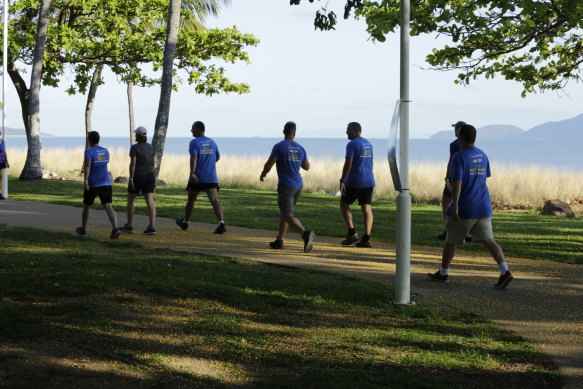- Perspective
- Politics
- Queensland
- Queensland votes
This was published 8 months ago
The state seats where votes may be worth more – or less
By Matt Dennien
Queensland is often touted as Australia’s most decentralised state, which makes things spanning its breadth – say, a government providing access to services, or a party campaigning for votes at an election – more difficult.
While the formal campaign period for the looming state election won’t officially start until October 1 when parliament is dissolved, senior MPs from Labor and the LNP have already fanned out across the state after the last sitting week.
Because a majority still live outside the capital, the regions often get more attention, particularly provincial cities like Townsville and Cairns which contain multiple and often more marginal electorates.

Then-LNP leader Deb Frecklington during a 2020 campaign stop in Townsville with local candidates – one of whom’s seat now has almost 20,000 fewer voters than the state’s most-populated: Coomera.Credit: Matt Dennien
Yet, sometimes those living and working in the regions don’t feel they’re heard by capital city decision-makers – a criticism of which major parties and MPs are acutely aware, neatly shown by Premier Steven Miles’ Cairns-based derision on Thursday of “those few people … in the inner city of Brisbane” wanting a new Olympic stadium.
But with the state’s population pendulum swinging increasingly toward a future where the majority calls Brisbane home (let alone the broader south-east in which they already do), will the regions key role in elections also begin to shift?
Unlikely, says John Mickel, a Queensland University of Technology adjunct associate professor, former parliamentary Speaker and state Labor minister.
This is because of the economic importance of these regional hubs which, throughout history, have played a proportionately larger role alongside the capital than other states.
“Any party wanting to win government” can’t afford to ignore them, Mickel told me. “Don’t ever, ever, in a state the size of Queensland, think that regionalism doesn’t matter.”
A key part of that regionalism is the reluctance – written into law – to allow some of the vast electorates spanning the north and west to be folded together. That’s before we even get into the arguments around north Queensland statehood.
This sentiment was partially behind the 2016 move to increase the number of seats in parliament from 89 (where it had been since 1986) to 93. Another factor? The number of voters in the state doubling over that period.
That average of almost 33,500 voters in each electorate ahead of the 2015 poll has now climbed to more than 39,500.
Redrawing seats through regular redistributions – the next to start in little more than a year ahead of the 2028 election – is meant to keep these numbers in each within 10 per cent of the average and ensure all votes are as equal as can be.
But the maths for seats larger than 100,000 square kilometres (Cook, Traeger, Gregory and Warrego) takes 2 per cent of that landmass and assigns it as “notional” voters – adding up to 9000 in the case of Gregory.
Population growth of the sort the south-east has had since the last redistribution in 2017 can also leave some electorates with thousands more than the average – 14,000 in the case of Coomera. Yet they still only elect one member.
The balancing act at both ends of the spectrum is this, Mickel says: resources needed for some MPs to cover vast areas, and others to offer the same democratic representation for many more voters.
Electoral analyst Ben Raue said the result of the extra voters given to large electorates was a “thumb on that scale which effectively means one less seat in Brisbane and one more seat in the regions”.
One way to avoid more and more voters piling up in south-east seats was to add more to the parliament. The notion of more politicians is probably more unpopular among some voters than MP pay rises.
“That would be a more democratic way to deal with that issue,” Raue offers. He notes that Queensland parliament’s unique lack of an upper house in Australia means it is already paying far fewer politicians what is ultimately a “trivial cost” compared to government budgets.
Mickel agrees: “That increase by four [seats in 2017] does not reflect anywhere near the population growth.”
He suggested what was needed is a formal parliamentary committee set up to “have a proper and informed discussion” about whether the state needs more politicians, and changes to compulsory preferential voting while it’s at it.
“Democracy costs money – we could easily do away with it and have just one person tell us what to do. Would that be better? I don’t think so.”
While politicians and parties are unlikely to want to talk much about the idea during this campaign, the electoral map will look different by the next regardless – perhaps in more ways than one. The question is by how much.
Start the day with a summary of the day’s most important and interesting stories, analysis and insights. Sign up for our Morning Edition newsletter.